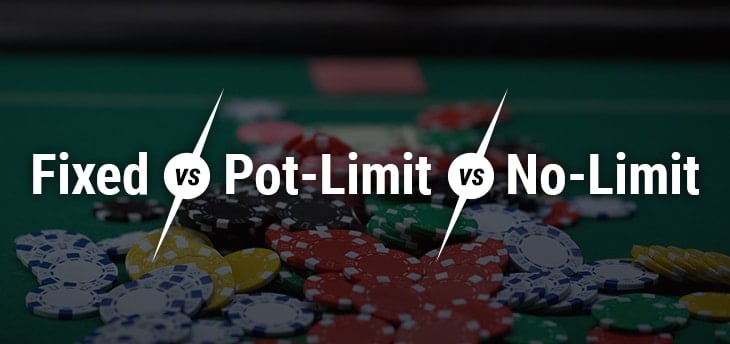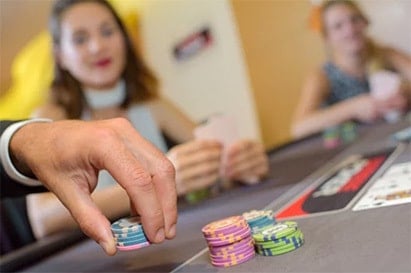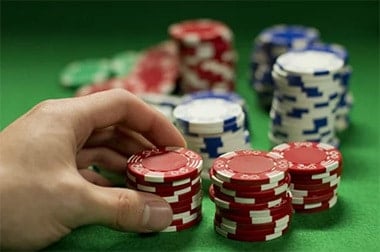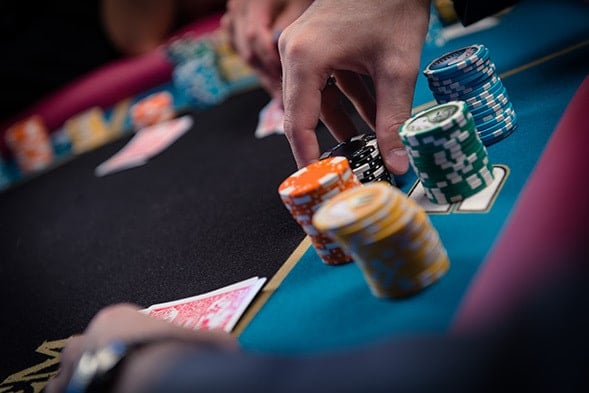The Beginners Guide Series: No Limit vs Pot Limit vs Fixed Limit

The Three Betting Structures
There are several reasons why poker is one of the biggest games in the world. For one, it is a versatile game you can play in many different ways. You can play it with any number of players, with different rulesets and for different stakes. This makes it a great game for both casual and serious players alike. While all of these options can change the game and the strategies used, it is important to know what they are in order to understand how they will affect the game. One of the biggest changes you can easily make to a poker game is the betting structure. In a poker game, there are 3 basic betting structures that are followed: No Limit, Pot Limit and Fixed Limit.

No-Limit
No-limit is the most common betting format for the world’s most popular poker variant, Texas Hold’em. As the name implies, there are almost no limits to how much you can bet. The only limit is you can’t bet more than you have, but you’re free to bet up to the size of your stack, which is known as pushing ‘All-In.’
There are two rules that govern the minimum bet size. First, you can never bet less than the big blind. Second, the minimum raise must be at least equal to the previous bet. For example, if the player before you bets $20, if you chose to put in a raise, it would have to be a minimum of $20, betting $40 in total. Of course, there is an exception to the two rules, if you have less than the big blind or the previous raise, you can still go All-In.
While there are no limits to how much you can bet into the pot, the smaller stack size in a heads-up match determines the effective limit, because you can’t force someone to bet more than they currently have, so there’s no point in betting more than a person’s stack size.
Emphasis on bluffing and aggression
No-limit poker is the most popular betting format because it is thrilling and exciting. With the ability to bet freely, players can use overbets to pull off incredibly daring bluffs. While this strategy can be effective, it also carries high risks, making no-limit poker just as skillful as the other formats. With the focus on aggressive play, no-limit poker has the potential to generate huge pots.

Fixed Limit
Fixed-limit is the most restrictive betting format, in which players are limited to specific bet sizes and even number of bets in a round. Fixed-limit games use “small” and “big” bet sizes. The small bet is equal to the big blind and is the only bet size available during the pre-flop and flop betting rounds. The big bet is double the small bet, and it is the only bet available on the turn and river.
Let’s take a look at a fixed-limit game with $1/$2 blinds.
After the blinds are paid, the player “under-the-gun” (UTG) has a few options. They can call $2, matching the big blind, or fold, mucking their cards to quit the hand. The player also has the option to put in a raise. If they do opt for a raise, the raise would have to be $2, adding a total of $4 to the pot. Fixed-limit games have a maximum number of bets (or raises) – usually four including the initial bet – in a single betting round. If the maximum is reached during a round of better, any player that can still act will only be able to call or fold.
There is also a variation of fixed-limit known as spread-limit. In these games, bet sizes are fixed to a range instead of one particular amount. A $2-$5 spread-limit game would allow you to bet or raise anywhere between $2 to $5. The only limitation is that any bet or raise must be at least as much as the previous one. So, if someone raises $4, you can’t follow with a raise of only $2, even if it is in the betting range. You would need to raise at least $4 more.
Emphasis on Math and Draws
Fixed-limit has the least volatility and risk among the three betting structures. While this is helpful for players afraid of big losses, it also means Fixed-Limit is often seen as the least exciting betting format. Overbetting as a bluff becomes impossible and places a heavier emphasis on pot odds and value betting. Consequently, the value of drawing hands increases since it’s less common to get forced out of the pot by a large bet.

Pot-Limit
Pot-limit gives players far more freedom when betting than fixed-limit but prevents the game from spiraling out of control as rapidly as no-limit. It is the most popular betting format for variants like Omaha poker.
In a pot-limit game, the total amount a player can bet is determined by the current size of the pot. Let’s use the same $1/$2 game as an easy example. With the big and small blinds in the pot, the current pot size is $3, and the UTG player faces the $2 big blind. The total possible raise size is equal to the current pot size plus the possible call, so the UTG could raise up to a maximum of $5 so the total they would put in the pot is $7.
Pot-limit can make for a slower pre-flop game, but the pot size has the potential to increase drastically. With $3 in the pot from the big and small blinds, even if everyone else folds and the small blind just calls to $2 the pot is now at $4. The big blind can raise $4 making the total pot $8. If the small blind was to re-raise here, they would put in $4 for the call and a raise of $12. Suddenly this small game has a pot of $24 with the big blind facing a $12 call and the ability to raise another $36 in just 2 actions.
Emphasis on Post-Flop Play
While pot-limit has far more potential for big pots compared to fixed-limit, that will usually happen after the flop, once the pot is decently sized. This places a lot of emphasis on good post-flop play, as it takes a lot of skill to navigate rapidly growing pots, especially without the ability to throw in a huge overbet like in no-limit.
In the end, it’s up to you to decide how you are going to play poker. Whether you enjoy the thrill and aggression of a no-limit game, the safety and emphasis on the math of a fixed-limit game, or the balance and emphasis on post-flop play of a pot-limit game, the choice is yours. The only suggestion we will make is, whatever you pick, make sure you enjoy it, afterall poker is supposed to be fun.
